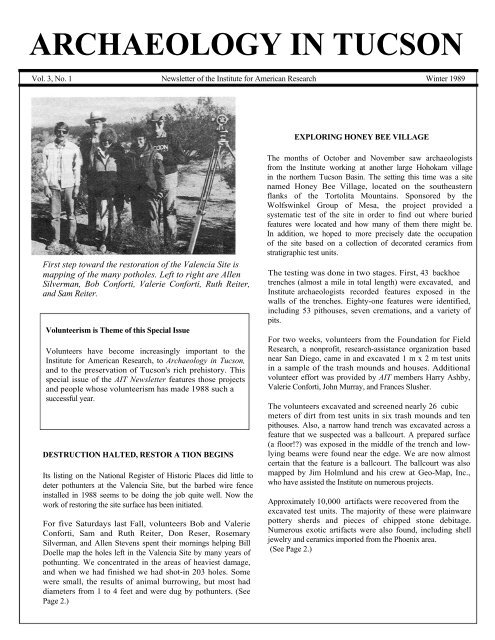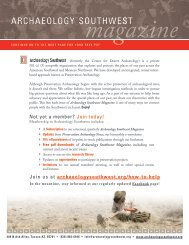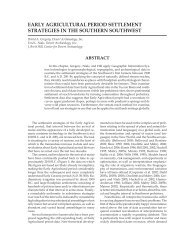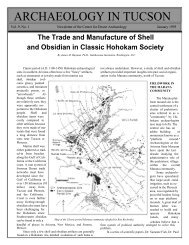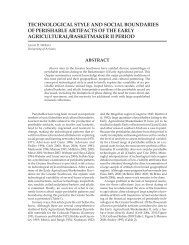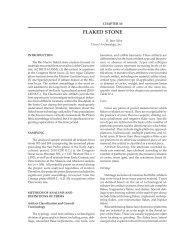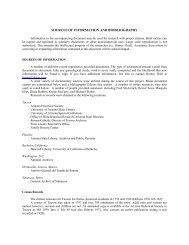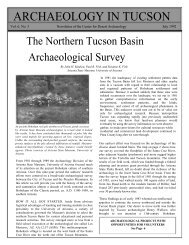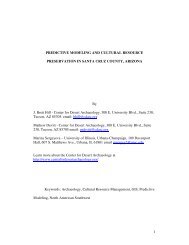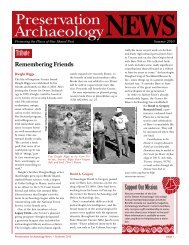Honey Bee Village - Archaeology Southwest
Honey Bee Village - Archaeology Southwest
Honey Bee Village - Archaeology Southwest
Create successful ePaper yourself
Turn your PDF publications into a flip-book with our unique Google optimized e-Paper software.
ARCHAEOLOGY IN TUCSON<br />
Vol. 3, No. 1 Newsletter of the Institute for American Research Winter 1989<br />
EXPLORING HONEY BEE VILLAGE<br />
First step toward the restoration of the Valencia Site is<br />
mapping of the many potholes. Left to right are Allen<br />
Silverman, Bob Conforti, Valerie Conforti, Ruth Reiter,<br />
and Sam Reiter.<br />
Volunteerism is Theme of this Special Issue<br />
Volunteers have become increasingly important to the<br />
Institute for American Research, to <strong>Archaeology</strong> in Tucson,<br />
and to the preservation of Tucson's rich prehistory. This<br />
special issue of the AIT Newsletter features those projects<br />
and people whose volunteerism has made 1988 such a<br />
successful year.<br />
DESTRUCTION HALTED, RESTOR A TION BEGINS<br />
Its listing on the National Register of Historic Places did little to<br />
deter pothunters at the Valencia Site, but the barbed wire fence<br />
installed in 1988 seems to be doing the job quite well. Now the<br />
work of restoring the site surface has been initiated.<br />
For five Saturdays last Fall, volunteers Bob and Valerie<br />
Conforti, Sam and Ruth Reiter, Don Reser, Rosemary<br />
Silverman, and Allen Stevens spent their mornings helping Bill<br />
Doelle map the holes left in the Valencia Site by many years of<br />
pothunting. We concentrated in the areas of heaviest damage,<br />
and when we had finished we had shot-in 203 holes. Some<br />
were small, the results of animal burrowing, but most had<br />
diameters from 1 to 4 feet and were dug by pothunters. (See<br />
Page 2.)<br />
The months of October and November saw archaeologists<br />
from the Institute working at another large Hohokam village<br />
in the northern Tucson Basin. The setting this time was a site<br />
named <strong>Honey</strong> <strong>Bee</strong> <strong>Village</strong>, located on the southeastern<br />
flanks of the Tortolita Mountains. Sponsored by the<br />
Wolfswinkel Group of Mesa, the project provided a<br />
systematic test of the site in order to find out where buried<br />
features were located and how many of them there might be.<br />
In addition, we hoped to more precisely date the occupation<br />
of the site based on a collection of decorated ceramics from<br />
stratigraphic test units.<br />
The testing was done in two stages. First, 43 backhoe<br />
trenches (almost a mile in total length) were excavated, and<br />
Institute archaeologists recorded features exposed in the<br />
walls of the trenches. Eighty-one features were identified,<br />
including 53 pithouses, seven cremations, and a variety of<br />
pits.<br />
For two weeks, volunteers from the Foundation for Field<br />
Research, a nonprofit, research-assistance organization based<br />
near San Diego, came in and excavated 1 m x 2 m test units<br />
in a sample of the trash mounds and houses. Additional<br />
volunteer effort was provided by AIT members Harry Ashby,<br />
Valerie Conforti, John Murray, and Frances Slusher.<br />
The volunteers excavated and screened nearly 26 cubic<br />
meters of dirt from test units in six trash mounds and ten<br />
pithouses. Also, a narrow hand trench was excavated across a<br />
feature that we suspected was a ballcourt. A prepared surface<br />
(a floor!?) was exposed in the middle of the trench and lowlying<br />
beams were found near the edge. We are now almost<br />
certain that the feature is a ballcourt. The ballcourt was also<br />
mapped by Jim Holmlund and his crew at Geo-Map, Inc.,<br />
who have assisted the Institute on numerous projects.<br />
Approximately 10,000 artifacts were recovered from the<br />
excavated test units. The majority of these were plainware<br />
pottery sherds and pieces of chipped stone debitage.<br />
Numerous exotic artifacts were also found, including shell<br />
jewelry and ceramics imported from the Phoenix area.<br />
(See Page 2.)
Page 2<br />
<strong>Archaeology</strong> in Tucson Newsletter<br />
Interestingly, there are indications that the village was<br />
subdivided into smaller segments, or precincts, consisting of<br />
30 to 50 associated houses, but a final say on this must await<br />
further analysis.<br />
RESTORING THE VALENCIA SITE<br />
About half of these holes have now been refilled, helping to<br />
return the site to a more natural appearance. However, the<br />
areas of the most severe pothunting will be left untouched, as<br />
a reminder of the destruction that selfish and uncaring<br />
persons can inflict so quickly on an archaeological site.<br />
On the positive side, our regular visits to the site confirmed<br />
that the fence placed around the site last March really is<br />
working to stop new pothunting. The fencing was<br />
accomplished through a joint effort, by the City of Tucson,<br />
the Arizona State Land Department, <strong>Archaeology</strong> in Tucson,<br />
and most importantly Fairfield Communities. The constant<br />
monitoring of the site by volunteer Barry Perron has been a<br />
critical element to ensure the effectiveness of the barbed<br />
wire.<br />
The most noteworthy find was a portion of a copper bell found<br />
near the bottom of one of the trash mounds. Copper bells are<br />
thought to have been manufactured in northern Mexico and are<br />
only rarely found on Hohokam sites. The presence of one at<br />
<strong>Honey</strong> <strong>Bee</strong> adds further support for the idea that the site's<br />
inhabitants were active in regional exchange networks.<br />
The Valencia Site has been a particular focus of the Institute<br />
for American Research since 1982, and it is truly gratifying<br />
to see that the site is receiving some of the protection and<br />
recognition that it deserves. This work will continue to be a<br />
priority for us in the future.<br />
Although artifact analyses are just now getting underway, it is<br />
already clear that the testing program was a resounding<br />
success. The site appears to have been first occupied during<br />
the late Pioneer or early Colonial period (roughly A.D. 800),<br />
and achieved its greatest size and population during the late<br />
Colonial and early Sedentary periods (A.D. 900-1000).<br />
Current evidence suggests that only a small residual group was<br />
left by the early Classic period (A.D. 1150-1300).<br />
The testing also provided much useful information on the<br />
organization of features at the site. For example, houses and<br />
house groups appear to be arranged around an open area, or<br />
plaza, in the central portion of the site. The ballcourt is located<br />
on the margin of the central plaza. At least one cemetery also<br />
appears to have been located there.<br />
The habitation area is bounded by a series of large trash<br />
mounds that are arranged in a roughly circular pattern around<br />
the houses. We now estimate there are somewhere between<br />
200 and 300 houses within a roughly 12 acre area.<br />
Three-quarter grooved axe from the surface of the<br />
Valencia Site.<br />
One of the exciting side lights of our mapping work was the<br />
discovery of a complete threequarter grooved stone axe<br />
within one of the potholes. This handsome tool provides<br />
evidence of the craftsmanship of the Hohokam. It also<br />
reminds us of the large amounts of human energy required<br />
not only to use tools made from stone, but also to<br />
manufacture them.
<strong>Archaeology</strong> in Tucson Newsletter Page 3<br />
VOLUNTEER OF THE YEAR<br />
The name Valerie Conforti appears in three other locations in this Newsletter, under three separate projects. She also worked on the<br />
Los Morteros testing project, which was featured in our last Newsletter. There was also the one day she worked in the lab—quickly<br />
finding that there are some aspects of archaeology that she does not like. Given her choice, Valerie would rather be surveying.<br />
Despite the intense summer heat she was a regular on the Gunsight Mountain survey this past year.<br />
Valerie is originally from England, having spent the past 23 years in the United States.<br />
She shares her love of archaeology with her husband Bob, who has also been a regular<br />
volunteer over the past year.<br />
Even with the hundreds of hours that Valerie has spent in the field with us, archaeology<br />
fills only a portion of Valerie's busy schedule. She paints in watercolor, has taken a number<br />
of archaeology classes at Pima Community College, and is currently learning Chinese.<br />
Jennifer, the Institute’s Bookkeeper and Office Manager, is a native speaker of Chinese. She<br />
says that Valerie's Chinese is coming along very well, and that her accent is "remarkable."<br />
The research program at the Institute for American Research has certainly benefited<br />
from the untiring contributions of this remarkable woman. We extend to her our sincere<br />
thanks. Naming Valerie our Volunteer of the Year only just begins to recognize the<br />
magnitude of her contributions. A search of our files yielded this photo of Valerie in her<br />
standard mode-working hard!<br />
FAIRFIELD WINS PRESIDENTIAL AWARD FOR ARCHAEOLOGY PROJECT AT CAMP COOPER<br />
Fairfield's Arizona Division has worked with the Tucson<br />
archaeological community in a variety of ways over the past<br />
five years. Activities include public and school tours when the<br />
Institute excavated the Tanque Verde Wash Site in 1984-85, a<br />
lead role in funding the fencing of the Valencia Site last<br />
spring, and significant aid in the development on an<br />
archaeological education program within the Tucson Unified<br />
School District. Fairfield recently received some well-deserved<br />
recognition for their efforts.<br />
On Monday, November 28, at 10 a.m., the red, white, and<br />
blue C-Flag, symbol of the President's Citation Program for<br />
Private Sector Initiatives, was raised over Camp Cooper, the<br />
Tucson Unified School District's environmental learning<br />
center on Trail's End Road in the Tucson Mountains. It is the<br />
only C-Flag awarded this year in Tucson and one of only six<br />
bestowed in the entire State.<br />
Dr. Paul Houston, superintendent of TUSD, accepted the flag<br />
from Dennis Wilkins, vice president of Fairfield Homes<br />
Arizona Division and president of Fairfield's three Tucson<br />
area communities.<br />
The flag was awarded to Fairfield Homes Arizona Division<br />
for donating the archaeology museum and funding the<br />
"<strong>Archaeology</strong> Is More Than a Dig" project at Camp Cooper.<br />
Houston, other officials, and the Tucson tradespeople who<br />
donated their time and expertise to the flag-winning<br />
improvement program at Camp Cooper were among the 300<br />
invited guests. After the brief ceremonies, which were<br />
covered by KGUN TV (Channel 9), archaeology classes<br />
resumed at Camp Cooper.<br />
Ten-year-old Luis Encinas, a fifth grader at Blenman<br />
Elementary School, is given an assist with the C-Flag<br />
by Fairfield's Dennis Wilkins.
Page 4<br />
<strong>Archaeology</strong> in Tucson Newsletter<br />
NEW DIRECTIONS FOR AIT<br />
<strong>Archaeology</strong> in Tucson is already well into its third year. We<br />
have achieved many of our original goals, but improvement of<br />
our program is a constant goal. In a recent survey of persons<br />
who were renewing their memberships, two areas were<br />
emphasized consistently. First, an expansion of the Newsletter<br />
was ranked highly, and second, opportunities to visit more<br />
sites were requested.<br />
Given the limited staff availability at the Institute, we find it<br />
difficult to offer regular site tours. Furthermore, the<br />
Archaeological and Historical Society already does a very<br />
good job of offering lectures and site tours each month. We try to<br />
ensure that our activities do not simply duplicate what is<br />
already available, and our site tours to date have featured sites<br />
where we have special expertise.<br />
We have come up with two new offerings. First, the present<br />
issue is a step toward an expanded Newsletter. Future issues<br />
will also follow an expanded format. Second, we plan to offer<br />
special classes for interested members. Some classes will<br />
provide a more thorough understanding of Tucson's<br />
archaeology, while others will teach archaeological field<br />
methods (see next article).<br />
The Spring 1989 class will be taught by Doug Craig and<br />
Mary Bernard-Shaw, both Research Archaeologists with the<br />
Institute. The following schedule is planned, but minor<br />
changes may be made to fit the schedules of class<br />
participants.<br />
1. The Research Design. An outline of how this class fits<br />
into the overall research goals of the Institute for<br />
American Research. 2 hour lecture/discussion.<br />
2. An Overview of Field Methods. Overview of the variety of<br />
field methods available to archaeologists and discussion<br />
of how to choose the appropriate techniques to meet<br />
specific goals. 2 hour lecture/discussion.<br />
3. The Joy of Paperwork. Introduction to the specific forms<br />
and procedures used by the Institute in the field and lab.<br />
Focus is on why so much paperwork is necessary and<br />
how to do it right. 2 hour lecture/discussion.<br />
4. On the Job Training. Six 8-hour days will be spent<br />
conducting small-scale test excavations at three different<br />
archaeological sites in the Tucson area. Each of these<br />
sites is threatened with damage or destruction by<br />
Tucson's growth.<br />
5. Review and Discussion. An informal review of what has<br />
been covered in the class, followed by a discussion of<br />
preliminary results and future research plans. 2 hours.<br />
LEARN ARCHAEOLOGICAL SKILLS!<br />
Stone Bowl—<br />
Valencia Site<br />
Excavations,<br />
1983.<br />
Professional archaeologists combine long years of work in the<br />
classroom with multiple seasons of field training in order to<br />
gain the skills required in this complex discipline. For the<br />
avocational archaeologist, reading, lectures, and field trips are<br />
important forms of self-education, but the opportunities for<br />
field experience are rather limited.<br />
In order to provide such opportunities, and to better integrate<br />
volunteers into our research program, the staff of the Institute<br />
for American Research will begin offering classes in basic<br />
field methods. The first class will focus on the use of smallscale<br />
hand-excavation techniques to obtain controlled samples<br />
from archaeological sites. In the future, survey and advanced<br />
excavation techniques will also be taught.<br />
Laboratory processing will be carried out during the week by<br />
Institute volunteers and staff during this course. It is hoped<br />
that class participants can arrange to spend some time in the<br />
laboratory to gain familiarity with this aspect of fieldwork.<br />
This class is limited to 10 participants, and a fee of $60 (a<br />
mere $10 per field day) is required. This fee covers a portion<br />
of the Instructor's wages. Other wages and the costs of<br />
artifact processing, analysis, and curation are covered by the<br />
<strong>Archaeology</strong> Fund of the Institute for American Research.<br />
This class is open only to <strong>Archaeology</strong> in Tucson members,<br />
and preference will be given to members who have<br />
volunteered on previous Institute projects. Please call<br />
Jennifer at 622-6663 to request an application form. All<br />
applications must be in by January 31. Applications will be<br />
evaluated and participants will be notified by February 7. The<br />
class will begin in mid-February, with fieldwork occurring<br />
every second Saturday until early May.
<strong>Archaeology</strong> in Tucson Newsletter Page 5<br />
GUNSIGHT MOUNTAIN SURVEY WINDING UP<br />
Fieldwork on the Institute's Gunsight Mountain National<br />
Register survey is expected to draw to a close in January or<br />
early February 1989. With the help of cash grants and<br />
volunteer labor contributions, Research Archaeologist Allen<br />
Dart has completely inventoried approximately six square<br />
miles near the north end of the Sierrita Mountains for<br />
archaeological material and has identified and recorded 130<br />
archaeological sites.<br />
financial officer; John Murray (129 hours), a retired U.S.<br />
Foreign Service official; and Patty Whitley (85.5 hours),<br />
who has also contributed over 200 hours in the Institute's<br />
lab and on our other field projects.<br />
Altogether, our Top Five have contributed over one-third of<br />
the total field hours volunteered on the Gunsight Mountain<br />
survey. Our sincere thanks to the Top Five and to the 60<br />
other amateur, professional, and student archaeologists who<br />
have contributed their time on the Gunsight Mountain<br />
project:<br />
Contributed More Than 50 Hours in Field:<br />
Mary Bernard-Shaw<br />
Bill Morris<br />
Allen Dart<br />
Don Reser<br />
Ken Fordyce<br />
Barbara Snyder<br />
Agnes Holladay<br />
Betty Wall<br />
Joan Lloyd<br />
Gunsight volunteers Harry Ashby, Barbara Snyder, Russ Wilde,<br />
Betty Wall, Karen Brownlee, and Patty Whitley.<br />
A future issue of <strong>Archaeology</strong> in Tucson will report on the<br />
discoveries made during the survey, after fieldwork is<br />
completed and a preliminary analysis can be done. In this<br />
issue we acknowledge those who have helped to make this<br />
project a success.<br />
The primary sponsor of the survey is the Arizona State<br />
Historic Preservation Office. They awarded the Institute a<br />
federal matching grant of $10,000 to do the survey and<br />
prepare a nomination of the sites in the Gunsight Mountain<br />
area to the National Register of Historic Places.<br />
To help match this amount, cash donations were provided to<br />
the Institute by the Tucson Community Foundation, Citibank,<br />
Holmes Tuttle Ford, Pima Savings, Van's Exxon Service, and<br />
directly to Allen Dart by the Arizona Archaeological and<br />
Historical Society. The remainder of the matching contribution<br />
was provided in the form of labor by numerous <strong>Archaeology</strong> in<br />
Tucson volunteers.<br />
As of New Year's Day 1989, the Top Five amateur<br />
archaeologists who contributed field time have been Valerie<br />
Conforti, a Pima Community College student who has worked<br />
334 hours in the field; Harry Ashby (210 field hours), a retired<br />
labor relations manager; Russ Wilde (156 hours), a retired<br />
Contributed More Than 25 Hours in Field:<br />
Dave Anderson<br />
Tom Kimmel<br />
Karen Brownlee<br />
Guy Pinkerton<br />
Dave Clutter<br />
Shirley Pinkerton<br />
Cindy Gibbs<br />
Doris Rickard<br />
Mary Josephs<br />
Also Contributed Field Hours:<br />
Connie Allen<br />
Patti Bell<br />
Brenda Benavente<br />
Jerry Bolt<br />
Barbara Buchanan<br />
Jean Carlin<br />
Mona Chaaban<br />
Janet Chumbley<br />
Debbie Clutter<br />
Bob Conforti<br />
Bill Doelle<br />
Saul Elasowich<br />
Tom Euler<br />
Lee Frau<br />
Edie Griffith<br />
Marilyn Hodges<br />
Wendy Jones<br />
Bobbie Lee<br />
Martina Mahone<br />
Jeff Maish<br />
Steve Malangone<br />
Nancy Marschner<br />
Betsy Marshall<br />
Mari Martin<br />
Sue Mathes<br />
Linda Mayro<br />
Woody McGinnis<br />
Cindy Mendelson<br />
Bruce Mettey<br />
Bruce Nix<br />
Vince O'Callaghan<br />
Rudy Piñon<br />
Kay Rosenow<br />
KaY Rowland<br />
Craig Stout<br />
Chris Szuter<br />
Ed Tuttle<br />
Sarah Tuttle<br />
Bert Whitley<br />
Contributed Lab/Office Hours<br />
Connie Bennett<br />
Henry Wallace<br />
Shirley Rivers
Page 6<br />
<strong>Archaeology</strong> in Tucson Newsletter<br />
JANUARY LECTURE AND SITE TOUR<br />
On Monday night, January 16, at 7:30 P.M., William<br />
Doelle will speak at the monthly meeting of<br />
the Arizona Archaeological and Historical Society on<br />
the topic "Tucson and Phoenix: Evidence for<br />
Prehistoric Rivalry?" Paul Fish, Archaeologist at the<br />
Arizona State Museum, will present an alternative point<br />
of view on the issue of prehistoric warfare in southern<br />
Arizona. All AIT members are invited to this lecture,<br />
which is held at the Biological Sciences West Building on<br />
the University of Arizona Campus in Room 301.<br />
On the following Saturday, January 21, there will be a<br />
tour of two large sites in the northern Tucson Basin.<br />
Arrangements for the tour must be made at the Monday<br />
night meeting. There is a small charge for the tour.<br />
LOS MORTEROS: THE FINAL PUSH<br />
Throughout the Fall, Jim Holmlund and Henry Wallace<br />
have continued to excavate at the site of Los Morteros<br />
whenever they could find a spare moment from their<br />
busy schedules. This postproject effort will very soon<br />
draw to a close when American Continental backfills<br />
all of the trenches in late January.<br />
An important last-minute contribution to this effort<br />
was provided by Dan Arnit, of Innovative Excavating, who<br />
gave us a full day of backhoe and operator time. This<br />
wasn't just any day, it was Christmas Eve Day! Dan's effort<br />
exposed a number of features that can resolve questions that<br />
arose after the end of fieldwork in August. Other<br />
volunteers that day were Mark Elson, Cathy Smith,<br />
Deborah Swartz, and Henry Wallace.<br />
ARCHAEOLOGY WEEK PREVIEW<br />
Arizona <strong>Archaeology</strong> Week 1989 is scheduled for March 12-<br />
18. The theme is "Tour the Past." For more detailed<br />
information than is presently available, feel free to call the<br />
Institute at 622-6663 in early March. The following are some<br />
of the key events that we are aware of in the Tucson area.<br />
March 14, Valencia Site Tour. Bill Doelle and Allen Dart<br />
will lead multiple tours of this Hohokam Ballcourt <strong>Village</strong><br />
throughout the day. By reservation only, no charge. Call<br />
Jennifer at 622-6663 after March 1 to make an appointment<br />
and to receive directions to the site.<br />
March 15, Arizona State Museum Open House. This is the<br />
day the Museum opens up its basement storage rooms to the<br />
public. There are primitive technology demonstrations and<br />
lots more. This happens in the late afternoon and early<br />
evening. Don't miss this opportunity.<br />
March 15, Lecture on the <strong>Archaeology</strong> of the Tucson Basin.<br />
By William Doelle, Director of the Institute for American<br />
Research. To be held at the Arizona Historical Society from 7-<br />
9 P.M. There is an admission charge.<br />
SCIENCE CAMP FEATURES ARCHAEOLOGY<br />
Those of you with children from 12 to 17 years of age may be<br />
interested to hear more about the Cottonwood Gulch<br />
Foundation of New Mexico. The Foundation was established in<br />
1935, and their brochure states:<br />
"The Prairie Trek (for boys 12 - 17) and Turquoise Trail (for<br />
girls 13-17) provide young men and women with a unique<br />
opportunity to explore places of cultural, scenic, and natural<br />
interest throughout the Four Corners states...discovering the<br />
prehistoric and modern life of the Pueblo Indian cultures,<br />
hiking among the 14,000 foot peaks of the Rockies, and<br />
investigating the physical structure of the land and its plant<br />
and animal life."<br />
For those with special interests in archaeology, there are<br />
opportunities to work in a pueblo ruin as well as visit many of<br />
the most famous archaeological sites in the <strong>Southwest</strong>. For<br />
more information write or call: The Cottonwood Gulch<br />
Foundation, P.O. Box 14957, Albuquerque, New Mexico<br />
87191. Telephone: (505)-293-3865.<br />
Foundation for Field Research volunteers Evelyn Mallory<br />
and Annetta Green at <strong>Honey</strong> <strong>Bee</strong> <strong>Village</strong>.
<strong>Archaeology</strong> in Tucson Newsletter Page 7<br />
RYE CREEK PROJECT TAKES US OUT OF THE TUCSON BASIN<br />
Last Fall the Institute was awarded a contract by the Arizona<br />
Department of Transportation to test and eventually excavate<br />
19 archaeological sites that will be impacted by the widening<br />
of a five mile stretch of State Route 87 (the <strong>Bee</strong>line Highway)<br />
just south of Payson. The pine and juniper trees of the<br />
mountains of Central Arizona make this a very different<br />
setting than the saguaro covered deserts of the Tucson Basin.<br />
This area has traditionally been called by archaeologists the<br />
heartland of the "Salado" culture. The Salado were a pueblo<br />
building people who lived in the mountains of Central Arizona<br />
between A.D. 1200 and 1450. Very little is known about these<br />
people and their origins (where they came from, who they<br />
are) are a subject of heated debate within <strong>Southwest</strong><br />
archaeology.<br />
Mark Elson and Deborah Swartz are heading up this project<br />
for the Institute. They spent ten weeks this Fall with a crew of<br />
eight making maps, surface collecting, and conducting test<br />
excavations at the 19 sites.<br />
The sites are a mixture of both small masonry pueblos and<br />
pithouse villages. The decorated ceramics suggest that the<br />
pithouse sites were occupied slightly earlier than the pueblo<br />
sites.<br />
Most of the sites with masonry architecture appear to be<br />
small field houses that were probably only briefly occupied.<br />
These sites are generally located near land suitable for<br />
farming and they are believed to be temporary or seasonal<br />
habitations for planting, protecting and harvesting the crops.<br />
The one larger site with masonry architecture, which may<br />
have contained as many as 10-20 rooms, was unfortunately<br />
found to have been heavily damaged by vegetation clearing<br />
activities conducted by the Forest Service in the mid-1960s.<br />
The pueblo sites appear to date between A.D. 1100 to 1300.<br />
The majority of the sites with intact remains were found to<br />
contain pithouses and are believed to date to the time interval<br />
between roughly A.D. 750 and 1100. This is a very important<br />
period in the Tonto Basin area, for it is very poorly known.<br />
New information about this period should help greatly in<br />
placing in context the questions about the origin and ethnic<br />
affiliation of the Salado culture.<br />
The testing report is now being written and the excavation<br />
phase of this project is expected to get underway by March.<br />
Future Newsletters will provide more detailed reports on the<br />
results of this exciting project.<br />
ARCHAEOLOGY WEEK 1989: "TOUR THE PAST"<br />
March 12-18<br />
The Institute for American Research is a private, nonprofit, research and educational organization that specializes in the<br />
preservation of the American past. The Institute was founded in 1968, and its headquarters are located at 300 North Los Carneros Road,<br />
Goleta, CA 93117. Telephone: 805-964-3549.<br />
In Arizona, the Institute specializes in the archaeology of the Tucson Basin and southern Arizona. <strong>Archaeology</strong> in Tucson (AIT) is a<br />
membership program of the Institute for American Research, and the AIT Newsletter is published quarterly. The Institute's<br />
Arizona offices are located at 245 South Plumer, Suite 14, Tucson, AZ 85719. Telephone: 602-622-6663.<br />
Annual Membership Rates. Individual ($10), Family ($15), Supporting ($25), Sustaining ($100), Patron ($500). Corporate Rates: Active<br />
($100), Supporting ($200), Sustaining ($500).<br />
To Join <strong>Archaeology</strong> in Tucson: Memberships in <strong>Archaeology</strong> in Tucson run for one year from the time they are received. Send your<br />
name, street address, city, state, and zipcode along with a check made out to the Institute for American Research to:<br />
ARCHAEOLOGY IN TUCSON 245<br />
South Plumer. Suite 14 Tucson.<br />
Arizona 85719


